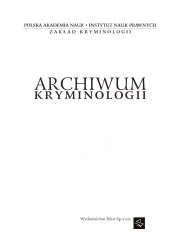Neutralizacja normy „nie kradnij” w genezie przestępczości nieletnich
Neutralization of the Rule „DO NOT STEAL” in the Origin of Juvenile Delinquency
Author(s): Barbara Stańdo-KaweckaSubject(s): Law, Constitution, Jurisprudence
Published by: Instytut Nauk Prawnych PAN
Keywords: neutralization of the rule; do not steal;origin of juvenile delinquency;
Summary/Abstract: The paper discusses the findings of a study aimed at an empirical verification of a well-known criminological concept: the Sykes and Matza concept of neutralization techniques from the classical trend of positivist criminology. What Sykes and Matza see as the factor of juvenile delinquency are mechanisms of justification of one’s own delinquent behawior. Reverting to functionalim, the authors assume a social consensus on the basic values and norms of behawior. Juvenile delinquents generally recognize the same values and norms as non- delinquent youth but, unlike that youth, they grow proficient in neutralizing those norms so as to prevent them from influencing their behawior. According to Sykes and Matza, norms are neutralized through finding and accepting justifications for one’s own deviant behavior. Five types of such neutralization techniques heve been distinguished according to the contents of those justifications: denial of responsibility, denial of injury, denial of the victim, condemnation of the condemners, and appeal to higher loyalties. In their conception of neutralization techniques, G.M. Sykes and D. Matza mainly describe and classify the ways of excusing one’s own deviant behawior and provide but a perfunctory discussion of the mechanizm of neutralization itself. L. Festinger’s theory of cognitive dissonance proves useful in explaining the psychological mechanizm of neutralization of recognized norms. Assumptions of the conception of neutralization techniques and the theory of cognitive dissonance provided the grounds for hypotheses which were subsequently submitted to empirical verification. The subject was limited to neutralization of the rule “do not steal” interpreted as a ban appropriation on theft and a rule of respect for another person’s property. Criminologists have long questioned the desing of empirical study where achool youth are treated as non-delinquent and examined as a control group oppesed to juvenile delinquents in houses of correction or educational institutions. In the present study, three groups were examined: ‒ juvenile delinquents confined to a reformatory or home for detained juveniles by a judicial decision as perpetrators of offences against property (84 persons); ‒ school youth not involved in acts against another person’s property, called non-delinquent youth (70 persons); ‒ school youth involved in acts againts another person’s property, called actually delinquent (37 persons); The groups of “non-delinquent” and “actually delinquent” persons were distinguished from school youth by means of a self-report survey. Of the original hypotheses, only one was confirmed by the findings. The exemined groups appeared to differ significantly in their approval of the techniques of neutralization of the norm of honesty, the differences trending as expected. The lowest approval of statements expressing various excuses for breaches of another person’s property was found among the non-delinquent youth. The group that most often approves ot such excuses are wards of reformatories and juvenile homes; however, they do not differ much in this respect from the actually delinquent youth. All of the examined groups have similar priorities as to the separate types of excuses. The type accepted most often is “condemnation of the condemners”. In particular, a statement that “the police and judges are corruptible and malicious”enjoys great popularity. The types accepted least often, instead, are excuses consisting in “denial of injury” and “appeal to higher loyalties”. What could not be conformed are hypotheses as to absence of differences between the groups with respect to appraisal of one’s own honesty and acceptance of the rule “do not steal”. Non -delinquent youth appraise themselves much higher in terms of honesty than the remaining two groups. Wards of reformatories and juvenile homes, instead, appraise themselves somewhat lower than the actually delinquent youth. The non-delinquent youth show the strongest acceptance of the norm of honesty. The degree of acceptance of that norm among wards of reformatories is similar to that among actual delinquents, the former showing a somewhat stronger acceptance of the rule “do not steal” than the actually delinquent group. Another hypothesis that was not confirmed concerned a tendency to neutralize the rule “do not steal” once it has been violated; the method used here was projection where the respondents were to complete unfinished stories. Against expectations, the tendency to neutralize that norm once it has been violated appeared to occur much more often among school youth than among wards of reformatories and juvenile homes. Of the various methods of reducing the anxiety resulting from a breach of another person’s property, both groups of school youth most often suggested neutralization of the norm of honesty. Wards of institutions, instead, much more often mentioned methods other than neutralization of the violated norm: e.g., focus on the derived or potential profit, or focus on the absence of threat with any negative consequences from without. The study questioned the role of delinquent neutralizations as conceived by Sykes and Matza in the origin of juvenile delinquency. Unforfunately, the findings could not be interpreted explicitly. According to the theoretical assumptions made, a number of possible explanations of the findings can be suggested which at least party exclude one another. A new empirical study would be necessary to verify those explanations.
Journal: Archiwum Kryminologii
- Issue Year: 1994
- Issue No: XX
- Page Range: 21-51
- Page Count: 31
- Language: Polish

